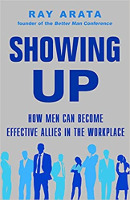
Image by Werner Heiber
When it comes to equity, belonging, and inclusion, most women and people of marginalized groups would be able to share quite clearly the challenges they routinely face, in their personal lives and work lives, just for being who they are. That is because it is their lived experience. They could illuminate what these challenges cost them, whether it be their personal or professional relationships, job opportunities, financial success, and even their own health and well-being.
Women and people of underrepresented groups would likely share that they are tired (exhausted, actually), stressed, resigned, sad, afraid, and angry. To hear and understand that this is their experience is to acknowledge their pain.
White Men Don’t Feel the Pain
Often, white men are unaware of the challenges, frustrations, and the short- and long-term impacts that these individuals face every day of their lives—because it’s not their lived experience. These same people might well be our friends, work colleagues, family members. Through the optics of a white man, the often-subconscious observation is that “All of this is happening around men, but not to men.” As for BIPOC* men and gay men, this may not be the case. (*Black, Indigenous, People of Color)
If we aren’t being denied opportunities based on our gender and our identities, or not having to work twice as hard to adhere to a double standard simply because of who we are, then it doesn’t get our attention—because it’s not happening to us. And this certainly is not an excuse. We’re simply not experiencing the pain.
One way to get men engaged as allies is to bring to their attention the experiences of people who don’t look like them or who are different to evoke some empathy. What follows is an example of an effective training strategy we use inside companies.
An Effective 4 Step Strategy
1. Presence the real-life experiences of others: In my work engaging men as allies and inclusionary leaders, I’ve witnessed time and time again that when I bring to men’s attention (without shame or blame) what is happening to the women they work with—that the women are having an entirely different experience than they are, under the same roof—it often comes as a surprise.
2. Leverage the power of senior leadership vulnerability: In the fall of 2018, my partner and I were hired to deliver a training to the male leaders of a well-known global newsroom. We initiated the process by interviewing three women and three men, to get a pulse of the then-current working environment. Each interview was slated for one hour. Calls with the men each concluded after twenty minutes. Their perspective of the workplace culture was that the men were open to change for the right reasons; that it was a good, diverse workplace (though things could always be better); and that the environment felt equal and open—merit-based.
Calls with the women went the full hour. What we heard was very different. We heard:
- Women are set up to fail—they are given difficult assignments with insufficient support, and if it doesn’t work, they’re gone.
- Men in the same situation get support and resources.
- Women need to be perfect to get a shot, and then they get training.
- Men can be less than perfect and get staff and support rather than training
When we shared our findings with the diversity leaders who hired us, they wanted us to not include the slide we had appropriately titled, “The tale of two companies.” (That’s not what happened.)
When you start on your journey, I ask that you allow all the feedback to be listened to. To not do so allows a form of complicity to take place. But when we showed the slide to the editor-in-chief, he insisted on keeping the slide as part of the presentation. In addition, he stood up in front of a room full of mostly men and made clear that this was not the kind of newsroom culture he wanted to see or be part of. He shared that he, too, had things to learn, that he made mistakes, and that he had not been as aware as he would have liked. He pledged to do more and committed to changing his behavior.
When a male leader stands up in front of a room of men, admits his own failings, takes accountability for what happens on his watch, and publicly commits to be better, it’s a powerful model to emulate and follow for the men in the room. It also sends the message to the women that men are capable of making the transition to be more inclusive.
3. Establish organizational guidance: Senior leaders must play a very strategic and important role in activating the men inside their organization. Identify that senior male leader who is willing to stand up in front of other men, be vulnerable, own his mistakes, and share his reason for why being an ally and inclusive leader is important to him as well as to the company.
The newsroom’s editor-in-chief took ownership of the work environment that was in place on his watch and made it clear that he would do his part in changing the current culture to be more inclusive. This is another step in the right direction to get men engaged, but it still falls short of what is required at a personal level for men to “activate” and get on board.
4. Activate empathy: When he finished, the room was eerily quiet. The looks on men’s faces were contrite, surprised, and questioning. We invited them to share their responses to what they heard and many of them said, “I had no idea,” “what can I do,” “this is not ok with me,” and other variations on these three common responses.
For these men, their ability to empathize started with the journey from their heads to their hearts—when they were able to hear and connect to the experiences of others in their own newsroom. We subsequently were hired to bring the same training to their UK office.
Making the Experience Real
Bringing live and tangible experiences of the women in your organization, without shame or blame, makes it real for men. Second, and of equal importance, is to present instances of racism.
When men are presented with this information—that their actions and inactions, language, and decisions are behind the experiences of the women and people of color they work with—most men want to be better. This is an experience to build upon.
Copyright 2022. All Rights Reserved.
Printed with permission of the author.
Article Source:
Showing Up
Showing Up: How Men Can Become Effective Allies in the Workplace
by Ray Arata In Showing Up, you’ll discover the DIY method of heart-based leadership Ray Arata has used with such companies as Verizon, Bloomberg, Moody's, Intel, Toyota, Hearst, and more—a male-modeled, real-solutions approach by and for men to increase diversity, bolster the bottom line, and create a culture so everyone in the workplace wins.
In Showing Up, you’ll discover the DIY method of heart-based leadership Ray Arata has used with such companies as Verizon, Bloomberg, Moody's, Intel, Toyota, Hearst, and more—a male-modeled, real-solutions approach by and for men to increase diversity, bolster the bottom line, and create a culture so everyone in the workplace wins.
Showing Up is a “how-to” book for men in organizations seeking to be better allies and leaders. The book also gives guidance to HR, Diversity & Inclusion Professionals on how to engage their men in diversity efforts. With stories that illuminate common missteps, followed by key learning sections, and deep-dive training exercises to support the development of allyship, Showing Up turns good intentions into specific actions you can implement immediately.
For more info and/or to order this book, click here. Also available as a Kindle edition and as an Audiobook.
About the Author
 Ray Arata is an award-winning diversity, equity, and inclusion (DEI) leader and speaker, consultant, and trainer, with global clients from PwC to Verizon to Toyota to Bloomberg. He founded the Better Man Conference for the development of healthy masculinity and men as allies and partners. He was recognized by UN Women in 2016 as a HeForShe Champion for Change and received the Ron Herring 2020 award.
Ray Arata is an award-winning diversity, equity, and inclusion (DEI) leader and speaker, consultant, and trainer, with global clients from PwC to Verizon to Toyota to Bloomberg. He founded the Better Man Conference for the development of healthy masculinity and men as allies and partners. He was recognized by UN Women in 2016 as a HeForShe Champion for Change and received the Ron Herring 2020 award.
His new book is Showing Up: How Men Can Become Effective Allies in the Workplace.
Learn more at RayArata.com and BetterManConference.com.
More books by this Author.


























